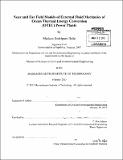| dc.contributor.advisor | E. Eric Adams. | en_US |
| dc.contributor.author | Rodríguez Buño, Mariana | en_US |
| dc.contributor.other | Massachusetts Institute of Technology. Department of Civil and Environmental Engineering. | en_US |
| dc.date.accessioned | 2013-07-10T14:49:23Z | |
| dc.date.available | 2013-07-10T14:49:23Z | |
| dc.date.copyright | 2013 | en_US |
| dc.date.issued | 2013 | en_US |
| dc.identifier.uri | http://hdl.handle.net/1721.1/79495 | |
| dc.description | Thesis (S.M.)--Massachusetts Institute of Technology, Dept. of Civil and Environmental Engineering, 2013. | en_US |
| dc.description | Cataloged from PDF version of thesis. | en_US |
| dc.description | Includes bibliographical references (p. 126-130). | en_US |
| dc.description.abstract | The world is facing the challenge of finding new renewable sources of energy - first, in response to fossil fuel reserve depletion, and second, to reduce greenhouse gas emissions. Ocean Thermal Energy Conversion (OTEC) can provide renewable energy by making use of the temperature difference between the surface ocean and deep ocean water in a Rankine cycle. An OTEC plant pumps huge volumes of water from the surface and nearly 1 km depth, and releases it at an intermediate depth. The effects of this enormous flux are crucial to understand since disruption of the ambient temperature stratification can affect the efficiency of the plant itself and of adjacent plants. This thesis aims to study the external fluid mechanics of offshore OTEC power plants, to assess their environmental impact and to help analyze whether OTEC plants can provide a sustainable source of energy. Although there has been interest in OTEC for several decades, so far primarily physical and analytical models have been developed. In this study numerical models are developed to model OTEC operating plants: integral models for the near and intermediate field and a large-scale ocean general circulation model. Two strategies in modeling OTEC plant discharge are used to analyze plume dynamics: the "Brute Force" approach, in which a circulation model, MITgcm, computes the near, intermediate and far field mixing; and the "Distributed Sources and Sinks" approach, in which the near and intermediate field are represented in the circulation model by sources and sinks of mass computed by integral models. This study concludes that the Brute Force modeling strategy is highly computationally demanding and sometimes inaccurate. Such simulations are very sensitive to model resolution and may require the use of unrealistic model parameters. The Distributed Sources and Sinks approach was found to be capable of modeling the plume dynamics accurately. This method can be applied to the study of adjacent OTEC power plant interaction, redistribution of nutrients, and propagation of contaminants. | en_US |
| dc.description.statementofresponsibility | by Mariana Rodríguez Buño. | en_US |
| dc.format.extent | 130 p. | en_US |
| dc.language.iso | eng | en_US |
| dc.publisher | Massachusetts Institute of Technology | en_US |
| dc.rights | M.I.T. theses are protected by
copyright. They may be viewed from this source for any purpose, but
reproduction or distribution in any format is prohibited without written
permission. See provided URL for inquiries about permission. | en_US |
| dc.rights.uri | http://dspace.mit.edu/handle/1721.1/7582 | en_US |
| dc.subject | Civil and Environmental Engineering. | en_US |
| dc.title | Near and far field models of external fluid mechanics of Ocean Thermal Energy Conversion (OTEC) power plants | en_US |
| dc.type | Thesis | en_US |
| dc.description.degree | S.M. | en_US |
| dc.contributor.department | Massachusetts Institute of Technology. Department of Civil and Environmental Engineering | |
| dc.identifier.oclc | 849649804 | en_US |
